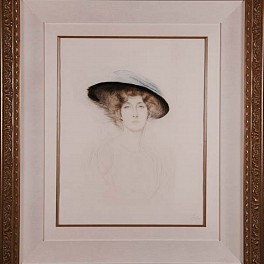BIOGRAPHY

1859 - 1927
Best known for his portraits of high society women, no other artist depicted the "Belle Epoque" more strongly in his work than Paul Cesar Helleu.
Helleu began his studies at the atelier of Jean Leon Gerome in 1876 at the École des Beaux-Arts. In the same year, Helleu attended the Second Impressionist Exhibition, where he met John Singer Sargent, James McNeill Whistler, and Claude Monet. After graduating school, he began his career by decorating ceramics at the Théodore Deck Ceramique Française. It was during this time that he met Giovanni Boldini, who would greatly influence his work.
In 1884 he undertook the task of painting the young Alice Guerin, then only 14 years old, with whom he fell in love. After a two year courtship the couple was married. Alice remained Helleu’s favorite model throughout his life, and through her charm helped introduce him to the aristocratic circles of Paris.
In 1885, after meeting James Jacques Tissot, he made his first attempt at drypoint etching. Over the following decades he was to execute over two thousand etchings, sometimes making only one or two copies of each subject. No other artist was able to capture the sensuous texture of fur and plumes which dominate his striking portraits of society's most beautiful women at the end of the nineteenth century.
His sitters included eminent personalities such as Queen Alexandre, Princess Patricia of Connaught, Comtesse de Greiffuhle, Madelaine Le Maire, and one favorite was Consuelo Vanderbilt -- the American born Duchess of Marlborough, whom he met in 1900. His prominent clientele introduced him into society both in England and also the USA where he was commissioned in 1912 to design the ceiling of the Great Hall of the Grand Central Station in New York.
The advent of the great war heralded the end of the "Belle Epoque" and saw the demise of Helleu's clientele and their elegant world of conspicuous consumption. He began to concentrate on oil paintings of majestic cathedral views, statues in the park at Versailles and vibrant still-life's of flowers. Although he continued to paint and draw until his death in 1927, he destroyed almost all his copper plates four years earlier when he realized that the Belle Epoche was over. In 1927, at the age of 67, he died of peritonitis following surgery in Paris.
